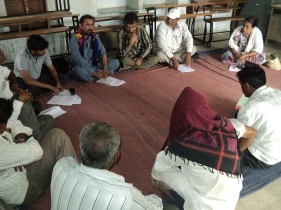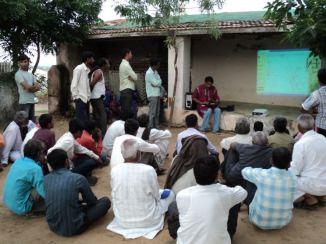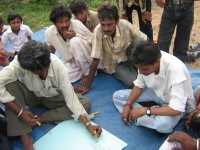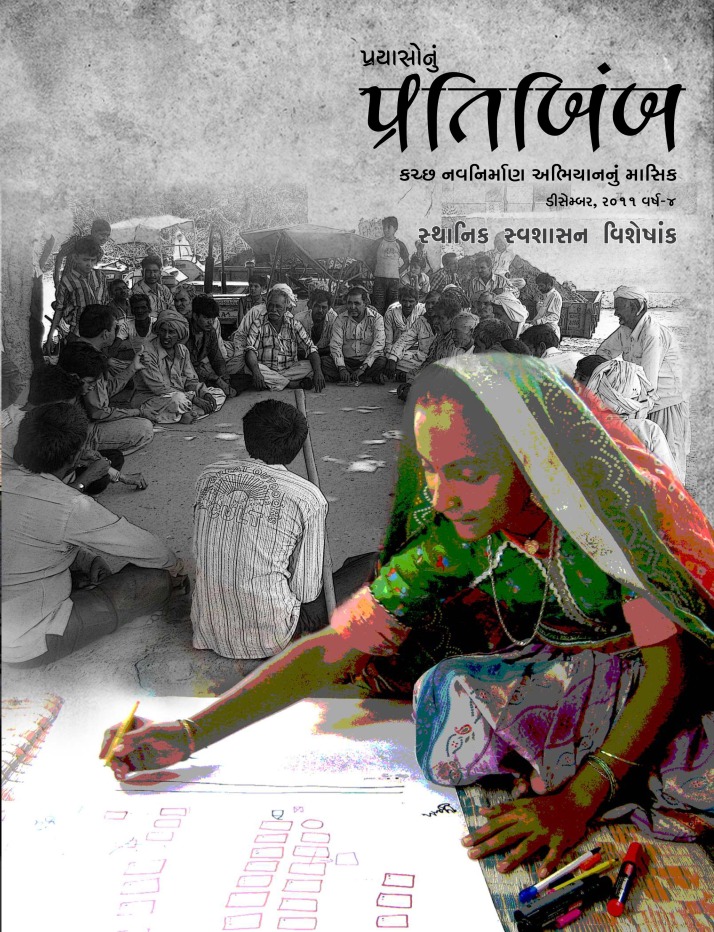Governance Self Assessment
 The Village Governance Fund (VGF) was introduced by Setus to transform the relationship between donors, NGOs, and communities; and to create platforms for Panchayats to sponsor and monitor the development of their villages. This un-tied fund enabled the Panchayats to undertake developmental agendas within the parameters of good governance, social justice, and equity. VGF provided an opportunity for Panchayats to hone their skills and legitimize their position as effective and responsive units of local self-governance. Taking into consideration the lengthy and in depth process of capacity building at various levels and through various modes, a tool was developed to assess the performance of Gram Panchayats in terms of governance parameters. In its pilot phase, three Gram Panchayats were subject to governance self assessment[1] with the following objectives:
The Village Governance Fund (VGF) was introduced by Setus to transform the relationship between donors, NGOs, and communities; and to create platforms for Panchayats to sponsor and monitor the development of their villages. This un-tied fund enabled the Panchayats to undertake developmental agendas within the parameters of good governance, social justice, and equity. VGF provided an opportunity for Panchayats to hone their skills and legitimize their position as effective and responsive units of local self-governance. Taking into consideration the lengthy and in depth process of capacity building at various levels and through various modes, a tool was developed to assess the performance of Gram Panchayats in terms of governance parameters. In its pilot phase, three Gram Panchayats were subject to governance self assessment[1] with the following objectives:
a) To institutionalize a system for Governance Self Assessment
b) To assess improved capacity of Panchayats in ‘Governance’
c) To assess improvement in support to marginalized communities by the Panchayats
d) To assess the direction of Setus for future intervention with Panchayats
e) To assess improvement in taxation by Panchayats
f) To assess change in record keeping practices of Panchayats
This tool for Governance Self Assessment was developed by Setu team with support from external resource persons, in consultation with individuals from the community and Panchayat Association. The Parameters taken into consideration for developing the framework included:
- Expectations of good governance from local communities
- Constitutional mandates, taking references from Fundamental rights, Directive principles and Fundamental duties of local governments.
- The Gujarat Panchayati Raj Act, provisions within, ‘subjects’ devolved to the Gram Panchayats by the State,
- Role of GPs in implementing various Centrally and State sponsored Schemes.

The Parameters were then categorized in 16 subjects and each subject was probed with advanced questions to make an assessment on Panchayat’s governance role.
These 16 subjects included:
- Local Governance administration
- GP finances
- GP body functioning
- GS functioning
- Transparency and accountability
- Provisioning of basic infrastructure and services
- Rule and norm making
- Planning
- Environmental Management and NRM
- Pro – Active Governance
- Traditional Governance expectations
- Equity and Justice
- Implementation effectiveness – NREGA
- Eco – development
- Land – Pasture, wasteland, encroachment, etc
- Level of Awareness
The Assessment output was converted into scores for each of the key parameters (sixteen), as well as an overall local governance index, thus allowing for comparisons across Panchayats. It also allows for easy trend analysis over time, point at the more intractable gaps etc.
The governance deficit pointed out by the assessment defined the areas for improvement for each local government which will influence the process of Local planning, making it much more robust and objective and bring much needed attention to critical governance issues, instead of only focusing on scheme’s and infrastructure development.
While piloting and strengthening the Governance Self Assessment (GA) as a tool to augment GPs’ performance on governance parameters, it was strongly felt that more number of Panchayats need to be covered under GA in order to establish the concept and institutionalize it with Panchayat Association. Panchayat Association, though were involved with assessing the pilot Panchayats, still need to enhance their skills as auditors, share the concept and piloting experiences to larger group of Panchayats of the region, organize sharing workshops among the Talukas. Moreover, most of the Gram Panchayats have newly elected members after the Gram Panchayat elections in the month of December 2011 and April 2012 in Gujarat and thus the Panchayat Association members would also change accordingly and the association would soon have new members in their Board. The ex members of Panchayat Association would continue their membership with the Association as co-opt members and as advisors. It is essential at this phase that the former and new members of Panchayat Association arrive at a common platform, share the experience and importance of Governance Self Assessment and take the process ahead together.
In the proposed period December 2012 to March 2013, Setus would facilitate the Panchayat Association to conduct Governance Self Assessment in 10 Panchayats spread across three Blocks of the District – Bhuj, Anjar and Rapar. The facilitation role includes:
Results till now:
The team of auditors prepared audit report of the three Panchayats – Rampar, Devadiya and Mathada, all belonging to Anjar Taluka of Kutch District and shared with the Panchayat body. Audit report was reflected as scores of each Panchayats in each of the governance parameters and also qualitative information with respect to the Parameter. Scores of each Panchayat for various governance parameters is reflected in the table below.
Table: Score of Panchayats on Governance Parameters
|
Sr. No
|
Subject
|
Mathada
|
Devadia
|
Rampar
|
|
1
|
Local Government administration
|
81.8
|
84.1
|
84.1
|
|
2
|
GP finances
|
69.3
|
64.0
|
50.9
|
|
3
|
GP body Functioning
|
43.5
|
31.5
|
89.7
|
|
4
|
GS functioning
|
25.0
|
21.9
|
–
|
|
5
|
Transparency and Accountability
|
58.3
|
58.3
|
66.7
|
|
6
|
Provisioning of basic Infrastructure and services
|
72.6
|
69.0
|
45.3
|
|
7
|
Rule and Norm Making
|
36.4
|
50.0
|
50.0
|
|
8
|
Planning
|
44.1
|
61.8
|
14.7
|
|
9
|
Environmental Management and NRM
|
50.0
|
25.0
|
20.8
|
|
10
|
Pro-Active Governance
|
43.6
|
54.8
|
40.2
|
|
11
|
Traditional governance expectations
|
56.7
|
66.7
|
70.0
|
|
12
|
Equity and Justice
|
88.1
|
78.6
|
20.6
|
|
13
|
Implementation effectiveness – NREGA
|
9.6
|
4.4
|
18.4
|
|
14
|
Eco – development
|
64.3
|
35.7
|
28.6
|
|
15
|
Land – pasture, wasteland, encroachment, etc
|
29.2
|
25.0
|
18.8
|
|
16
|
Level of awareness
|
89.8
|
66.7
|
76.9
|
|
Governance INDEX
|
52.6
|
48.8
|
41.9
|
Note: In Rampar Panchayat the team of auditors missed out giving score to Gram Sabha parameters and captured qualitative information for the parameter and hence the table above does not show Gram Sabha related score of Rampar Panchayat.
Future plan for Governance Self Assessment
| Activities |
December |
January |
February |
March |
| Weeks |
| 1 |
2 |
3 |
4 |
1 |
2 |
3 |
4 |
1 |
2 |
3 |
4 |
1 |
2 |
3 |
4 |
| Governance Self Assessment |
|
|
|
|
|
|
|
|
|
|
|
|
|
|
|
|
| Formation of Assessment teams |
Y |
Y |
|
|
|
|
|
|
|
|
|
|
|
|
|
|
| Training for the Assessment teams |
|
|
|
Y |
|
|
|
|
|
|
|
|
|
|
|
|
| Workshops for creating platform for Panchayat Associations to bring Panchayats together |
|
|
|
|
Y |
Y |
|
|
|
|
|
|
|
|
|
|
| Tool printing |
|
|
|
|
|
Y |
|
|
|
|
|
|
|
|
|
|
| Executing Governance Self Assessment |
|
|
|
|
|
|
Y |
Y |
Y |
|
|
|
|
|
|
|
| Facilitation in preparing Assessment report |
|
|
|
|
|
|
|
|
Y |
Y |
Y |
|
|
|
|
|
| Sharing with the assessment reports with the Panchayats |
|
|
|
|
|
|
|
|
|
|
|
Y |
Y |
|
|
|
| Documentation |
|
|
|
|
|
|
|
|
|
|
|
|
|
Y |
Y |
Y |
The term Governance Audit was changed to Governance Self Assessment on request of the Panchayat Association.
23.251671
69.662560
 Context:
Context:






